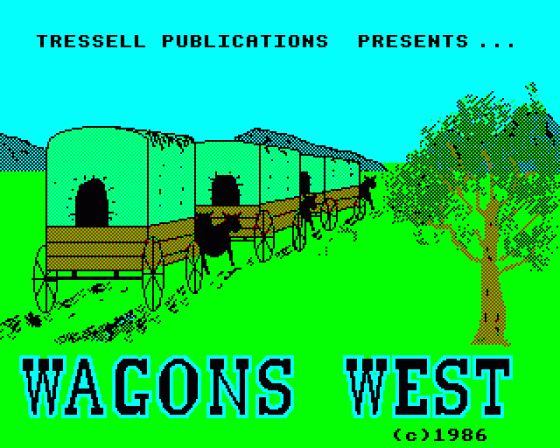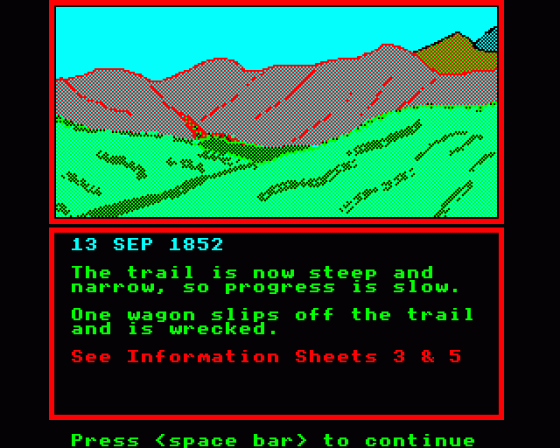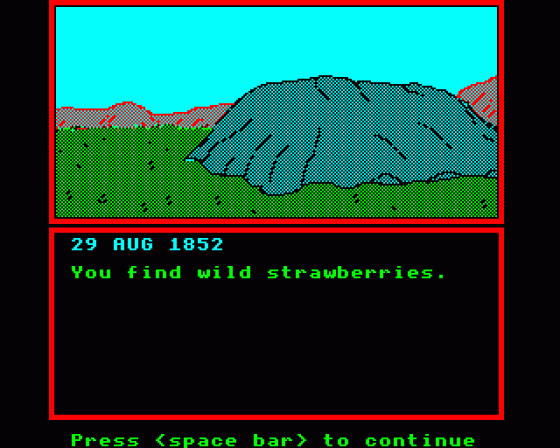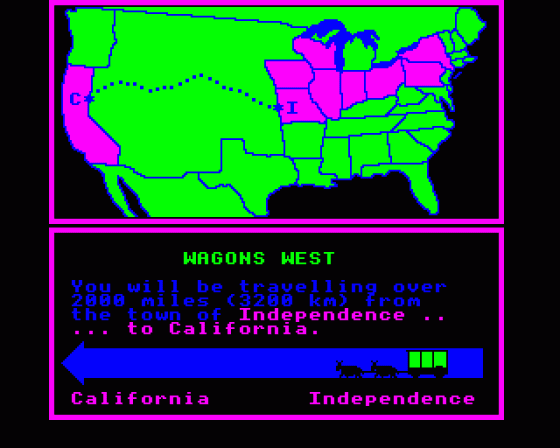
Acorn User
 1st February 1988
1st February 1988
Categories: Review: Software
Author: Chris Drage
Publisher: Tressell
Machine: BBC Model B
Published in Acorn User #067
Historical simulation packages are a real boon in the classroom when well thought out and presented
How The West Was Won
"Dear Beatrix, I have reached California and I wish you were here to see how beautiful it is. The weather is getting warmer but I hope it doesn't get too hot. It took us ages getting to California and I expect you'll be coming here as well. Ma and Pa are getting the houses built, but I am sure it will take a long time. Love from Jesse."
So writes Farah, a twelve year old from a west London middle school. During eight weeks in 1987, Farah's class of 25 mixed-ability children embarked on a hazardous crossing of the North American continent. They were simulating the passage of real emigrant pioneers through a resource package called Wagons West from Tressell Publications. This work was part of the humanities curriculum on migration. In the October 1987 issue of Acorn User we discussed in detail how adventure software, in the hands of a skilled teacher committed to resource-based learning, can lead children into worlds beyond their direct experience. The same can be said for simulation software such as Wagons West.
Wagons West is based on groups of children adopting a mid-19th century pioneer family and helping them traverse the North American continent to arrive safely in California.
The Preparations

The class had access to only one computer for only one morning a week, so the work had to be carefully organised to maximise the use of the limited time available.
Resources were gathered: the pack suggests a bibliography of eleven children's and fourteen teacher's titles. In addition, filmstrips, slides and posters were obtained. Extra copies of books were taken from the library and photocopies of a number of the maps and worksheets from the pack were made. Wagons West itself provides a number of support materials which give relevant historical, geographical and sociological information, along with contemporary written accounts and illustrations.
As an introduction, the children embarked on some general map work about North America from class atlases. This gave them some familiarity with the lie of the land and the major geographical obstacles they were to meet in their progress west: the Rockies, the Platte River and so on. The teacher was very concerned that the children, having been fed on a diet of popular Hollywood westerns, might embark on the study with the wrong attitudes and expectations. She showed them a series of slides depicting the real "wild west", and this led to a more informed discussion about the hardships of the pioneers and the hazards they faced. An interesting side issue about the role of the indigenous American Indians also arose.

The children chose their own work groups of three or four, based on friendships. This was done deliberately, as the program expects the children to take on the role of one particular family. It was hoped that this arrangement would help children experience some measure of group empathy. However, Tressell suggests that each group should have at least one very competent reader and this was achieved by subtly guiding the grouping.
The simulation began with the children choosing which group they would represent - a group comprises two families from a common location, for example 'Marion Group' comprises the Chapman and the Salter families from Marion, Indiana. Before the journey begins an extensive fitting out section must be completed. To assist this vital part of the simulation, the pack provides group cards, fitting out record sheets, information sheets, a poster and a computer program. This range of materials proved vital in the once-a-week computer session, engaging all the children while groups worked in rotation at the single computer. It took two whole morning sessions to complete this part of the simulation. The children were very amused by the bartering which had to be done over the sale of bullocks, and each group ended up paying a different price. The program guides the children into making sensible choices about supplies to purchase, and inadequate and inadequate preparations are avoided.
The Journey
For this part of the simulation the pack provides trail maps, journey record sheets, nine information sheets and a poster The quality of these supporting materials is excellent. Information sheets provide background material but require a high reading age. This is why each group should have an above average reader. They proved suitable for twelve year olds.
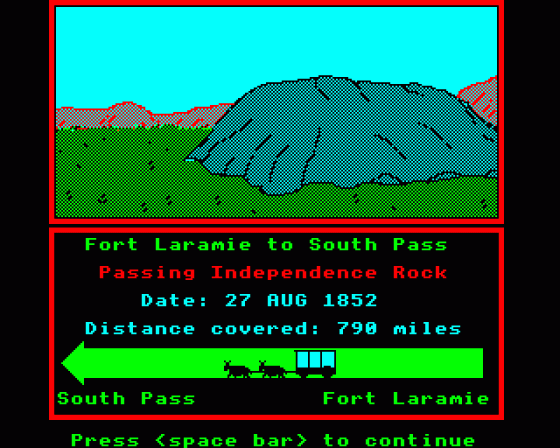
During the simulated journey, the children met many of the people and problems that the real pioneers encountered. At each stage the children were given a number of choices and how successful they were depended on the decisions that they took. There was an impressive amount of discussion that ensured and some maturity of thought went behind each decisions that they took. There was an impressive amount of dicussion that ensued and some maturity of thought went behind each decision with the twelve-year-old group. The process of gathering information and recording events was made as interesting as possible - the children kept diaries, made sketches of people they met, made taped interviews with Indians and 'mountain men', and generally recorded their work in a variety of different ways.
The historical authenticity of Tressell's packages brings children close to the experiences of the emigrants, as is evident from the diary entry below for stage two of the journey by the Marion Group:
-
12th June 1852
So now we start our journey. The trail follows the Platte River. -
14th June 1852
One of the children in our group fell into the Platte River and got sucked in by the mud and drowned. -
16th June 1852
We saw a small group of Indians approaching our wagon train. We had a choice of what to do: fire guns to scare them away, offer them cattle or horses in return for a safe journey, or invite them for a meal. We decided to trade for a safe passage. The Indians kept their promise, and let us travel safely through. -
20th June 1852
One of our group's wagons overturned in the South Platte and was wrecked. Several wagons in the train had wheels or tyres broken off. -
25th June 1852
We came across a woman all alone. She said her husband had died of cholera two days earlier. We had to leave her behind because we didn't have room. But we gave her food. We were lucky because we learnt later that she died of cholera too. -
27th June 1852
Not far from Fort Laramie now. -
29th June 1852
We reached Sioux Indian country so we had to take care and watch over the animals at night. We lost two oxen. -
2nd July 1852
Several wagons in the train had broken wheels or tyres off. We had to stop for a day to make repairs. -
4th July 1852
At last! We have reached Fort Laramie. Thank God for that.
As each group reached California, individual children also had to write letters home to relatives describing their feelings on arrival, as Farah wrote to Beatrix at the beginning of the article.
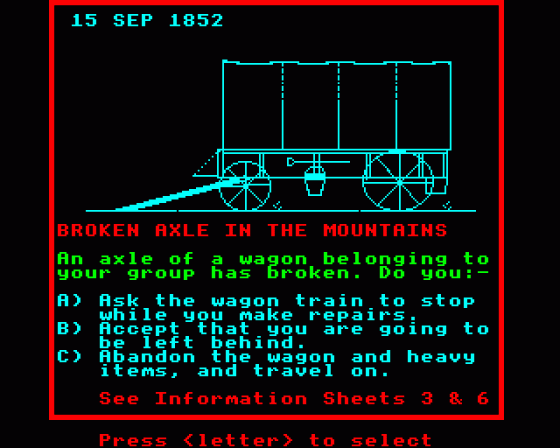
This class of twelve-year olds concluded their work by presenting their experiences to the assembled school, where they relived the trials and tribulations of their migration.
For children to become totally absorbed in a simulation, as this group obviously were, requires the teacher to develop positive attitudes and encourage sound decision making thorough discussion and a degree of preliminary work. It's evident that a great deal of empathy is generated by this package, as children become aware that the only means of survival involves compromises with the other families in the train.
Each teacher will use this pack in their own manner: often this is constrained by the organisation of the class, curriculum, computer(s) and school. In this case there are a number of activities which could not be done; had a second computer been available, word processing, information retrieval and desktop publishing would have also been available to the children. One group were keen to make a newspaper with reports from various pioneers. A knowledgeable visitor might have been found to talk to the children. And had the school been near Bath, a visit to the city's American Museum could have been made as part of the preparations and background study.
The motivation and work generated by Wagons West is quite remarkable. The preparation section of the simulation provides the historical background necessary for the children to become aware of the needs and problems of pioneers. What makes Wagons West such a valuable teaching aid is the fact that it is original, it encourages lots of group work away from the computer, and it helps to provide a focal point for a wide range of activities.
Get It Here
Wagons West is available from Tressel Publications, Lower Ground Floor, 70 Guard Parade, Brighton BN2 2BA. £29.75 on 5.25" disc or £31.95 on 3.5" disc.
Other Reviews Of Wagons West For The BBC Model B
Wagons West (Tressell)
You think your life's tough going? Emigrate! People have been doing just that for many years. Dave E hitches up a covered wagon to this long-thought-lost educational gem.

